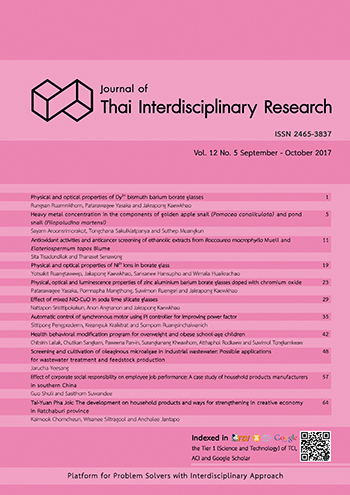Screening and cultivation of oleaginous microalgae in industrial wastewater: Possible applications for wastewater treatment and feedstock production
Main Article Content
Abstract
The aim of this research is to isolate local oleaginous microalgae from the Nakhon Chai Si and Tha-jeen river basins (Nakhon Pathom, Ratchaburi, and Samut Sakhon provinces) for potential use as feedstock for biodiesel fuel production. Colonies of microalgae were separated using a sterile micropipette washing method. Five strains of green microalgae (Botryococcus sp., Chlorella sp., Scenedesmus sp., Volvax sp. and Dunaliella sp.) and one of the cyanobacteria Spirulina sp. were isolated. The isolates were grown in selective media under photoautotrophic conditions in the laboratory. The results showed that Chlorella sp. yielded the highest amount of lipid production at 28.35% of dry cell weight. Spirulina sp. showed the lowest amount of lipid production at 7.75% of dry cell weight, but exhibited the highest specific growth rate (μ) at 0.412 d-1 when compared with other strains. The effects of varied physical-chemical conditions for cultivating Chlorella sp. in wastewater from an industrial plant were estimated. The results showed that wastewater from an instant food processing plant with a dilution rate with a basal medium at 1:10 (volume by volume), cultivated at light intensity 3,000 lux and 150 rpm agitation speed yielded a specific growth rate of 1.752 d-1 with 0.84 gL-1 of dry cell mass, 30.8% lipid production and yielded the highest lipid production rate at 53.96 mgL-1d-1. Moreover, the effectiveness of lipid production simultaneously with wastewater treatment by Chlorella sp. was also studied. The results demonstrated that when cultivating Chlorella sp. in a wastewater medium diluted with a basal medium at a dilution rate of 1:10 (volume by volume), Chlorella sp. could decrease the level of initial COD from 1,650 to 154 mgL-1 (90.67%) with a COD removal rate 195 mgL-1d-1. This set of conditions also yielded 1.4 gL-1 of dry cell mass with a specific growth rate 1.758 d-1 and 31.1% of lipid production, respectively. The fatty acids of lipid derived from isolated Chlorella sp. contains mostly palmitic acid (53.7%) and also contains similar fatty acids as those in plant oil. Chlorella sp. has potential for cultivation in wastewater from agricultural plants and could possibly serve as a model for better utilization of factory wastewater in the development of cost-effective biodiesel production in the future.

